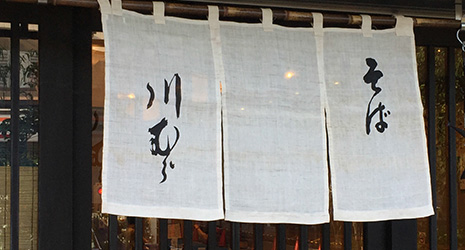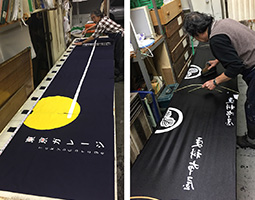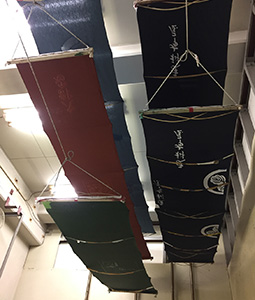INDEX
- English
- 日本語

Noren created by Katayama Akira at a soba noodle shop in Nippori, Tokyo - English
- 日本語

Katayama cuts out a paper stencil

Katayama Akira at work on two noren 
Noren hung out to dry
September 2020
Noren: The Face of a Shop

Noren, made of cloth and hung at the entrances of restaurants, bars and other establishments in Japan, are each uniquely designed and proudly displayed. Traditional noren are carefully made by hand by artisans who have inherited the craft.

In addition to fixed signage, curtain-like cloths called noren are displayed by many restaurants, bars and other establishments in Japan. Noren are hung at the entrance when the store opens and taken inside when the store closes. Customers pass through the noren when entering the shop and pass through them again to leave. Many noren are dyed with patterns that symbolize the shop’s name and show the type of shop it is. While noren have been used since ancient times as sunshades, wind and dust shields, and screens for shop entrances, they have also functioned as advertising and signage for shops. In a sense, noren are the “face” of a shop. In Japan, there is an expression: “To damage the noren.” In this expression, the noren hanging from the shop represents trust in that shop and its reputation and status, and damaging the noren represents damaging trust in that shop.
The Katayama Noren Dyeing Factory, located along the Sumida River in Arakawa City, Tokyo, has been making noren for around 100 years, mainly for bars and restaurants, including many soba noodle shops, with soba being a representative food culture of Tokyo. Third-generation factory owner Katayama Akira continues this traditional work by hand, taking pride in creating a face for shops.
The creation of a conventional noren on which, for example, a white text or designs stand out from a dark blue background, first begins with the creation of paper stencils by cutting out the text or designs. The stencil is then placed on top of the cotton or hemp fabric and covered with a paste resist made from glutinous rice flour. The fabric is then soaked in dye or painted with dye using a brush, and the fabric is imbued with a vivid blue. The beautiful white designs are then revealed when washing off the paste. Katayama’s techniques have been recognized as being distinctive in the area, and have been designated as intangible cultural properties by Arakawa City.

Katayama says, “A fabric’s strength is increased through dyeing. Noren need to hold their vivid colors for many years at a shop. This is why the joy is so great when noren are used continually for a long time. In the past, there were many shops that changed their noren according to the season, using hemp noren in summer and cotton in winter. It’s sad to see such a tradition die out.”
Up until the time of Katayama’s predecessor, many dyeing factories gathered along the nearby Sumida River, and you could see people washing out paste in the river water, but today Katayama’s factory is the only one left in the area.
However, Katayama says that orders from all over Japan have come flooding in, as traditional, handmade products are in demand. He also says that lately, clients thoroughly communicate their preferences and features of their shops while directly speaking with factory staff, and they often create noren that are not strictly bound by tradition.

Takumi, Katayama’s son who has taken over as the fourth-generation factory owner, is involved in designing new, unprecedented, and modern patterns in collaboration with other designers, as well as in activities to communicate the tradition and beauty of dyed textiles to the general public through hosting indigo dyeing workshops. Takumi has also recently taken on the challenge of planting seeds and growing indigo and madder, the plants used as materials to dye noren fabric, on his own in the Tokyo metropolis. He also plans to produce towels, placemats and cushions featuring family crests and other such emblems using noren-making techniques.
As the traditional techniques of noren making are passed on, so new forms of expression through dyeing continue to be created.

